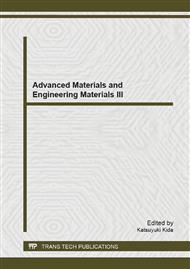[1]
ASTM Book of Standards F543-07 Standard Specification and Test Methods for Metallic Medical Bone Screws ASTM International.
Google Scholar
[2]
Battula, S., Schoenfeld, A., Vrabec, G., Njus, G.O., Experimental evaluation of the holding power/stiffness of the self-tapping bone screws in normal and osteoporotic bone material. Clinical Biomechanics 21(2006) 533–537.
DOI: 10.1016/j.clinbiomech.2005.12.020
Google Scholar
[3]
Daga, B., Rivera, G. and Boeri, R., Review of the regulations for the use of stainless steels for orthopedic implants in Argentina, Journal of Physics: Conference Series 90, IOP Publishing Ltd, (2007).
DOI: 10.1088/1742-6596/90/1/012045
Google Scholar
[4]
Dewo, P., Magetsari, R., Busscher, H.J., van Horn, J.R., Verkerke, G.J., Treating natural disaster victims is dealing with shortages: An orthopaedics perspective, Technology and Health Care, 16 (2008) 255-259.
DOI: 10.3233/thc-2008-16403
Google Scholar
[5]
Gefen, A., Optimizing the biomechanical compatibility of orthopedic screws for bone fracture fixation, Medical Engineering & Physics, Department of Biomedical Engineering, Elsevier Science Limited, Tel Aviv, vol. 24 (2002) 337–347.
DOI: 10.1016/s1350-4533(02)00027-9
Google Scholar
[6]
Haje, D.P. and Volpon, J.B., Bovine Bone Screws Development: Machining Method And Metrological Study With Profile Projector, Acta Ortopaedi, Brasil 14(2) (2006) 87-91.
Google Scholar
[7]
Hou, S.M., Hsu, C.C., Wang, J.L., Chao, C.K. and Jinn Lin, Mechanical tests and finite element models for bone holding power of tibial locking screws, Journal of Clinical Biomechanics , Elsevier Ltd., vol 19 (2004) p.738–745.
DOI: 10.1016/j.clinbiomech.2004.04.012
Google Scholar
[8]
Laksono, P.W., Mahardika, M., Suyitno, Puntodewo, Prihandana, S.P., Salim, U.A. dan Arifianto, B., Manufacturing Processes of Bone Screws for Orthopaedic Implant By Conventional Lathe Machine, Proceeding of the 1st International Conference on Materials Engineering (ICME) and 3rd AUN/SEED-Net Regional Conference on Materials (RCM), Yogyakarta, (2010).
DOI: 10.1063/12.0006002
Google Scholar
[9]
Laksono, P.W., , Study of Human Bone Screw Fabrication, Tesis, The Graduate School of Engineering Faculty Gadjah Mada University Yogyakarta, (2012).
Google Scholar
[10]
Magetsari., R, van der Houwen, E.B., Bakker, M.T.J., van der Mei, H.C., Verkerke, G.J., Rakhorst, G., Hilmy, C.R., van Horn, J.R., Busscher H.J., Biomechanical and surface physico-chemical analyses of used osteosynthesis plates and screws - Potential for reusein developing countries? J Biomed Mater Res B: Appl Biomater; 70 (2006).
DOI: 10.1002/jbm.b.30534
Google Scholar
[11]
Mahardika, M., Suyitno, Puntodewo, Prihandana, S.P., Arifvianto, B., Laksono, P.W. dan Wijono, S., Design and Manufacturing of bone screw for Orthopedic Implant, Proceeding International Conference on Industrial Engineering Service Science (IESS), Surakarta, (2011).
Google Scholar
[12]
Marciniak, J, Kaczmarek, M., Walke, W., and Cieplak, J., Biomechanical Analysis of Plate for Corrective Osteotomy of Tibia, Information Tech. in Biomedicine, ASC 47 (2008) 545–550.
DOI: 10.1007/978-3-540-68168-7_62
Google Scholar
[13]
Mudali, U.K., Shridar, T.M., and Raj, B., Corrosion of Bio Implants, Sadhana, 28 (3-4) (2003) 601-637.
Google Scholar
[14]
Muller, M.E., Allgower, M., Schneider, R., and Willenegger, H., Manual of Internal Fixation: Techniques Recommended by the AO-ASIF Group, Springer-Verlag, Berlin (1991).
Google Scholar
[15]
Sivakumar, M. and Rajeswari, S., Investigations of failures in stainless steel orthopaedic implant devices: Pit induced stress corrosion cracking. J. Mater. Sci. Lett. 11: (1992) 1039–1042.
DOI: 10.1007/bf00729754
Google Scholar
[16]
Uthoff, H.K., Poitras, P. dan Backman, D. S, Internal plate fixation of fractures: short history and recent developments, Journal of Orthopaedic Science, vol 11 (2006) 118-126.
DOI: 10.1007/s00776-005-0984-7
Google Scholar


